Émile Jean Horace Vernet was a French painter and diplomat. He came from a famous artistic dynasty: his father was the animalist Charles Vernet and his grandfather was the landscape painter Claude Joseph Vernet.
In his youth, the painter received an excellent education in humanities; he was trained in art by his father. In 1812, at the age of 23, Vernet presented his works for the first time at the most prestigious exhibition in Paris called the Salon. His paintings were instantly appreciated not only by the critics but also by the royals: Vernet became one of the most fashionable artists of the French capital and had a brilliant career.
Vernet became known primarily as a battle painter. He depicted battles and shipwrecks, fights and combats. The focus of his work was people in extreme situations and the turbulent, wild environment.
Vernet painted in other genres as well. He painted portraits, as well as biblical and everyday scenes. He also produced lithographs, drawings and even caricatures.
In 1829, Vernet was appointed director of the French Academy in Rome, where he lived for six years. The artist then returned to Paris to head a painting school.
Vernet traveled a lot, particularly attracted to exotic countries. In 1833, he visited Algeria with the French army. Wearing his country’s uniform, Vernet never took part in battles. Nevertheless, he interviewed soldiers who returned from the battlefield in order to accurately portray the war, its progress and specifics.
“Arab Holding the Head of the Killed Man” is a characteristic example of the painter’s battlefield oeuvre. In the center is a dark-skinned rider holding the head of a slain enemy, a European soldier, in his outstretched right hand. The figure of the white horse is brilliantly painted: it is depicted galloping, with its front legs in the air. The dust raised by the hooves and the smoke from the gunfire complete the picture of the battle.
All the features of Vernet’s style can be seen in this work: Oriental exoticism, superficial romanticism, expressiveness, color and light and shade contrasts, smooth manner of depiction, realism and focus on detail.
In the late 1930s, King Louis-Philippe of France created the Museum of the country’s military history in Versailles. Vernet painted a series of paintings glorifying the colonization of the North African lands. Since that time, the artist is considered to be the founder of Orientalism in painting.
In his youth, the painter received an excellent education in humanities; he was trained in art by his father. In 1812, at the age of 23, Vernet presented his works for the first time at the most prestigious exhibition in Paris called the Salon. His paintings were instantly appreciated not only by the critics but also by the royals: Vernet became one of the most fashionable artists of the French capital and had a brilliant career.
Vernet became known primarily as a battle painter. He depicted battles and shipwrecks, fights and combats. The focus of his work was people in extreme situations and the turbulent, wild environment.
Vernet painted in other genres as well. He painted portraits, as well as biblical and everyday scenes. He also produced lithographs, drawings and even caricatures.
In 1829, Vernet was appointed director of the French Academy in Rome, where he lived for six years. The artist then returned to Paris to head a painting school.
Vernet traveled a lot, particularly attracted to exotic countries. In 1833, he visited Algeria with the French army. Wearing his country’s uniform, Vernet never took part in battles. Nevertheless, he interviewed soldiers who returned from the battlefield in order to accurately portray the war, its progress and specifics.
“Arab Holding the Head of the Killed Man” is a characteristic example of the painter’s battlefield oeuvre. In the center is a dark-skinned rider holding the head of a slain enemy, a European soldier, in his outstretched right hand. The figure of the white horse is brilliantly painted: it is depicted galloping, with its front legs in the air. The dust raised by the hooves and the smoke from the gunfire complete the picture of the battle.
All the features of Vernet’s style can be seen in this work: Oriental exoticism, superficial romanticism, expressiveness, color and light and shade contrasts, smooth manner of depiction, realism and focus on detail.
In the late 1930s, King Louis-Philippe of France created the Museum of the country’s military history in Versailles. Vernet painted a series of paintings glorifying the colonization of the North African lands. Since that time, the artist is considered to be the founder of Orientalism in painting.




